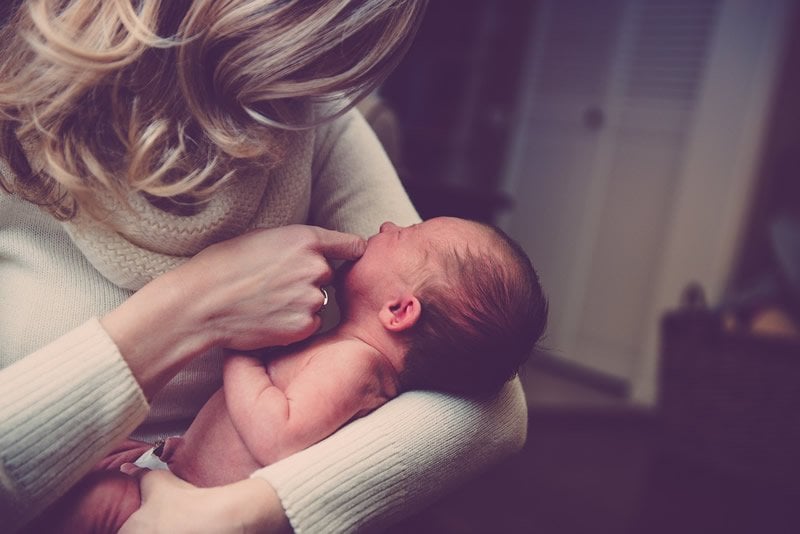Summary: Women who experience postpartum mental health problems such as depression and anxiety following the birth of their first child are 31% less likely to have more children.
Source: European Society of Human Reproduction and Embryology
Women who suffer from psychiatric disorders such as depression, anxiety, mania and schizophrenia following the live birth of their first child are less likely to go on to have more children, according to the first study to investigate this in a large nationwide population.
The study, which is published today in Human Reproduction, one of the world’s leading reproductive medicine journals, found that 69% of women who experienced postpartum psychiatric disorders within the first six months after the birth of their first baby went on to have further children; this contrasts with 82% of mothers who did not experience psychiatric problems.
However, Dr Xiaoqin Liu, a post-doctoral researcher at the National Centre for Register-based Research at Aarhus University (Denmark), who led the study, said: “An important message to women who have a history of severe postpartum psychiatric disorders is that it is possible to prevent relapse. We recommend that they seek help from their family doctors or psychiatrists if they want to have another child, so that plans for treatment that are specific for their individual needs can be made to reduce the risk of relapse, and so that their health, well-being and symptoms can be closely monitored and treated.”
Previous research has shown that, overall, around three percent of women develop psychiatric disorders in the first three months after childbirth. These disorders encompass a wide range of mental health problems and usually involve a combination of abnormal thoughts, behaviours and relationships with other people. To date, there has been little research into whether or not this affects women’s subsequent reproduction.
Dr Liu said: “We wanted to explore whether women with postpartum psychiatric disorders had a reduced possibility of having a second child. Furthermore, we considered whether a reduction in the live birth rate was due to personal choices or decreased fertility, as these are important issues to consider.”
Dr Liu and her colleagues analysed data from Danish registries for 414,571 women who had their first live birth between 1997 and 2015 in Denmark. They followed the women for a maximum of 19.5 years until the next live birth, emigration, death, their 45th birthday or June 2016, whichever occurred first.
They identified women with postpartum psychiatric disorders by seeing if they were given prescriptions for psychotropic medications or had hospital contact for psychiatric disorders during the first six months after the live birth of their first child.
A total of 4,327 (1%) of women experienced psychiatric disorders following the birth of their first child. These women were a third less likely to have a second live birth compared to women who did not experience psychiatric disorders. If the first child died, the difference in subsequent live birth rates disappeared. However, if the psychiatric problem required hospitalisation, the likelihood of a woman having a second child nearly halved and this remained the case irrespective of whether the first child survived or not.
Dr Liu said: “Although fewer women with postpartum psychiatric disorders had subsequent children, it is noteworthy that about 69% of these women still chose to have a second child. For the remaining 31% of women, we need to differentiate the reasons why they did not have another child. If they avoided another pregnancy due to fear of relapse, an important clinical message to them is that prevention of relapse is possible.
“Women whose first child died were nearly four times as likely to have a subsequent live birth as women whose first child survived. These findings suggest that the overall reduced rate of subsequent live births among women who experienced psychiatric disorders after the birth of their first child is, at least in part, voluntary.”

The researchers say that other possible explanations for the reduction in the subsequent live birth rate may be that women with postpartum psychiatric disorders are less able to conceive or have more problematic relationships with partners.
“The reason why women with postpartum psychiatric disorders choose to have fewer children needs to be explored further,” said Dr Liu.
A limitation of the study is that, although the researchers had an almost complete follow-up of the women through the Danish registries, they did not have accurate information on stillbirths or miscarriages; only pregnancies that led to a live birth were included in the study. Another limitation is that not all women with psychiatric disorders might have received medications or hospital treatment. In addition, it might not be possible to generalise the findings of the study to populations in other countries.
“Denmark offers free and easily available healthcare to all individuals, so we believe our results can inform other, similar populations, although we cannot rule out local differences,” concluded Dr Liu.
Source:
European Society of Human Reproduction and Embryology
Media Contacts:
Press Office – European Society of Human Reproduction and Embryology
Image Source:
The image is in the public domain.
Original Research: Open access
“Postpartum psychiatric disorders and subsequent live birth: a population-based cohort study in Denmark”. Xiaoqin Liu et al.
Human Reproduction doi:10.1093/humrep/deaa016.
Abstract
Postpartum psychiatric disorders and subsequent live birth: a population-based cohort study in Denmark
STUDY QUESTION
Are women with a history of first-onset postpartum psychiatric disorders after their first liveborn delivery less likely to have a subsequent live birth?
SUMMARY ANSWER
Women with incident postpartum psychiatric disorders are less likely to go on to have further children.
WHAT IS KNOWN ALREADY
Women are particularly vulnerable to psychiatric disorders in the postpartum period. The potential effects of postpartum psychiatric disorders on the mother’s future chances of live birth are so far under-researched.
STUDY DESIGN, SIZE, DURATION
A population-based cohort study consisted of 414 571 women who had their first live birth during 1997–2015. We followed the women for a maximum of 19.5 years from the date of the first liveborn delivery until the next conception leading to a live birth, emigration, death, their 45th birthday or 30 June 2016, whichever occurred first.
PARTICIPANTS/MATERIALS, SETTING, METHODS
Postpartum psychiatric disorders were defined as filling a prescription for psychotropic medications or hospital contact for psychiatric disorders for the first time within 6 months postpartum. The outcome of interest was time to the next conception leading to live birth after the first liveborn delivery. Records on the death of a child were obtained through the Danish Register of Causes of Death. Cox regression was used to estimate the hazard ratios (HRs), stratified by the survival status of the first child.
MAIN RESULTS AND THE ROLE OF CHANCE
Altogether, 4327 (1.0%) women experienced postpartum psychiatric disorders after their first liveborn delivery. The probability of having a subsequent live birth was 69.1% (95% CI: 67.4–70.7%) among women with, and 82.3% (95% CI: 82.1–82.4%) among those without, postpartum psychiatric disorders. Women with postpartum psychiatric disorders had a 33% reduction in the rate of having second live birth (HR = 0.67, 95% CI: 0.64–0.69), compared to women without postpartum psychiatric disorders. The association disappeared if the first child died (HR = 1.01, 95% CI: 0.85–1.20). If postpartum psychiatric disorders required hospitalisations, this was associated with a more pronounced reduction in live birth rate, irrespective of the survival status of the first child (HR = 0.54, 95% CI: 0.47–0.61 if the first child survived, and HR = 0.49, 95% CI: 0.23–1.04 if the first child died).
LIMITATIONS, REASONS FOR CAUTION
The use of population-based registers allows for the inclusion of a representative cohort with almost complete follow-up. The large sample size enables us to perform detailed analyses, accounting for the survival status of the child. However, we did not have accurate information on stillbirths and miscarriages, and only pregnancies that led to live birth were included.
WIDE IMPLICATIONS OF THE FINDINGS
Our study is the first study to investigate subsequent live birth after postpartum psychiatric disorders in a large representative population. The current study indicates that postpartum psychiatric disorders have a significant impact on subsequent live birth, as women experiencing these disorders have a decreased likelihood of having more children. However, the variations in subsequent live birth rate are influenced by both the severity of the disorders and the survival status of the first-born child, indicating that both personal choices and decreased fertility may have a role in the reduced subsequent live birth rate among women with postpartum psychiatric disorders.
STUDY FUNDING/COMPETING INTEREST(S)
This work was supported by the Danish Council for Independent Research (DFF-5053-00156B), the European Union’s Horizon 2020 research and innovation programme under the Marie Sklodowska-Curie grant agreement No. 837180, AUFF NOVA (AUFF-E 2016-9-25), iPSYCH, the Lundbeck Foundation Initiative for Integrative Psychiatric Research (R155-2014-1724), Niels Bohr Professorship Grant from the Danish National Research Foundation and the Stanley Medical Research Institute, the National Institute of Mental Health (NIMH) (R01MH104468) and Fabrikant Vilhelm Pedersen og Hustrus Legat. The authors do not declare any conflicts of interest.
TRIAL REGISTRATION NUMBER
N/A.






